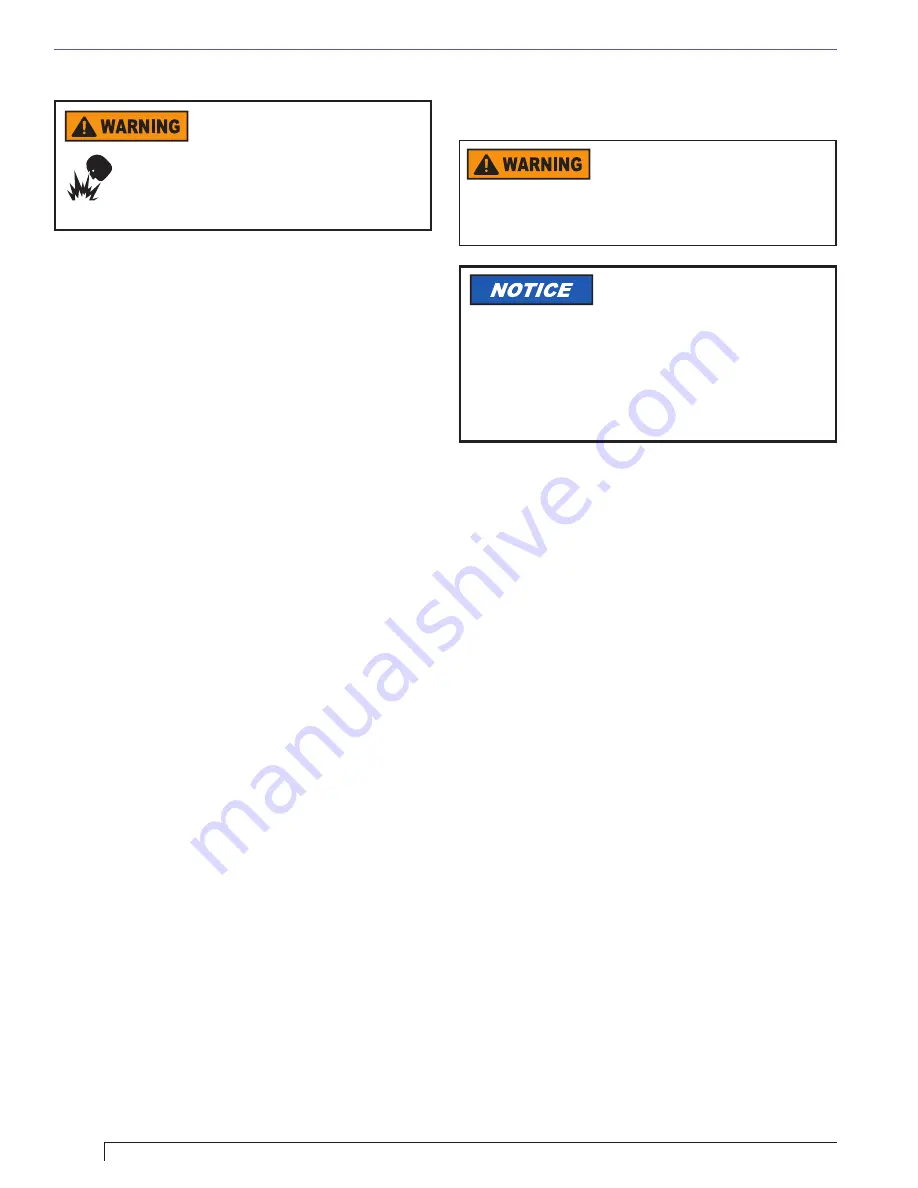
Section: COMBUSTION AIR ADJUSTMENT PROCEDURE
28
Validate Safety Control Operation
Explosion, Fire, and
Asphyxiation Hazard
Testing by Qualified Technician Required.
Failure to properly test and verify the
correct function of operation and safety
controls could lead to equipment malfunction.
The testing of operating and safety controls requires
technical training and experience with power gas
burners and appliances.
Carefully follow the manufacturer’s instructions supplied
with the appliance and the controls.
Verify the correct function of all operating and safety
controls used in the installation.
If instructions are not available, use the following
recommended procedures and record all results in a
start-up log.
1.
High limit/ Pressure Control
– To check the High
Limit, raise the temperature or pressure of the
operating control to a higher level and lower the
limit to a setting less than the operating control.
Run the burner until the high limit opens and shuts
the burner off. Adjust the controls back to the
desired settings.
2.
Operating control
– Run the burner until the
operating control shuts it off. If necessary, make
adjustments to ensure the control cycles the burner
in the desired temperature or pressure range.
3.
Low water cutoff (LWCO)
– With the burner firing,
open the blow down valve on the low water cutoff,
if applicable. As the water level drops, the LWCO
switch contacts open and shut the burner off. When
the water level rises, the LWCO contacts close
and restart the burner. Monitor the LWCO switch
operation in relation to the water level in the sight-
glass for synchronization.
4.
Verify Flame Sensor Function
– If 7590 operation
sequence and function is correct, turn off power
and remove sensor wire from bottom of 7590
control. Turn on power and fuel and initiate Call for
Heat. Verify that burner fires up and the gas valve
closes. After control locks out, flame shall go off.
Combustion Air Adjustment
Procedure
CO Leakage, Asphyxiation
Failure to maintain proper stack temperature could
result in flue gas condensing and cause chimney
damage.
Always use calibrated test
instruments to set combustion
levels. Verify that test instruments are calibrated and
in good working condition. If not already provided,
drill test access holes in the flue pipe near the breech
(or upstream of the boiler breech damper, if
applicable) and in the front mounting plate area for
firebox pressure. Be careful not to damage any
water-backed surface.
1. Initiate a call for heat.
2. Adjust the draft, over-fire, or breech pressure to the
appliance manufacturer’s recommended level after
flame has stabilized.
3. Measure the carbon monoxide level and adjust
air settings. An operating range of 0 - 50 PPM is
recommended for the CG10 burner.
4. Before making these tests, operate the burner to
allow the heating system temperature to stabilize or
nearly reach steady-state levels.
5. Measure the O
2
or CO
2
at the 50 PPM CO level. It
is recommended that you measure the oxygen (O
2
)
early in the test sequence because high levels of
carbon monoxide (CO) can be created at very low
or very high O
2
levels. The typical operating range
is between 3%-5%.
6. Open the air adjustment until the O
2
level is
increased by at least 1% or to 3% O
2
(whichever
is higher). This should reduce the CO level and
provide a margin of reserve air to accommodate
variable conditions.
7. Sample the CO level again. It should be in the 0 to
50 PPM range.
8. Check the draft to ensure it still meets
specifications. If a major change in draft is required,
repeat the above steps.























